Research on Deformation and Failure Control Technology of a Gob-Side Roadway in Close Extra-Thick Coal Seams
Abstract
:1. Introduction
2. Background and Method
2.1. Engineering Overview
2.2. Model Construction
2.3. Boundary Condition
2.4. Roadway Monitoring Line Layout
3. Results and Discussion
3.1. Deformation and Damage Characteristics of the Gob-Side Roadway under Existing Support Conditions
3.2. Stress and Displacement Distribution Law of the Roadway Wall under the Roadway Wall Reinforcement
3.2.1. Optimization of the Support Method of the Roadway Wall
3.2.2. Deformation and Damage Characteristics of the Roadway Wall
3.3. Stress and Displacement Distribution Pattern of the Roadway Wall under the Floor Reinforcement
3.3.1. Optimization of the Roadway Floor Support Method
3.3.2. Deformation and Damage Characteristics of the Roadway Floor
3.4. Field Application and Validation
4. Conclusions
4.1. Main Contributions
4.2. Limitations and Prospects
Author Contributions
Funding
Institutional Review Board Statement
Informed Consent Statement
Data Availability Statement
Acknowledgments
Conflicts of Interest
References
- Yang, H.Y.; Cao, S.G.; Wang, S.Q.; Fan, Y.C.; Wang, S.; Chen, X.Z. Adaptation assessment of gob-side entry retaining based on geological factors. Eng. Geol. 2016, 209, 143–151. [Google Scholar] [CrossRef]
- Li, X.L.; Chen, S.J.; Wang, S.; Zhao, M.; Liu, H.; Gong, F. Study on in situ stress distribution law of the deep mine taking Linyi Mining area as an example. Adv. Mater. Sci. Eng. 2021, 2021, 5594181. [Google Scholar] [CrossRef]
- Tan, Y.L.; Ma, Q.; Zhao, Z.H.; Gu, Q.H.; Fan, D.Y.; Song, S.L.; Huang, D.M. Cooperative bearing behaviors of roadside support and surrounding rocks along gob-side. Geomech. Eng. 2019, 18, 439–448. [Google Scholar] [CrossRef]
- Wang, Q.; He, M.C.; Yang, J.; Gao, H.K.; Jiang, B.; Yu, H.C. Study of a no-pillar mining technique with automatically formed gob-side entry retaining for longwall mining in coal mines. Int. J. Rock Mech. Min. Sci. 2018, 110, 1–8. [Google Scholar] [CrossRef]
- Wang, X.; Lu, M.Y.; Gao, Y.H.; Luo, W.B.; Liu, W.G. Structural Mechanical Characteristics and Instability Law of Roof Key Block Breaking in Gob-Side Roadway. Adv. Civ. Eng. 2020, 2020, 6682303. [Google Scholar] [CrossRef]
- Han, C.L.; Zhang, N.; Li, B.Y.; Si, G.Y.; Zheng, X.G. Pressure relief and structure stability mechanism of hard roof for gob-side entry retaining. J. Cent. South Univ. 2015, 22, 4445–4455. [Google Scholar] [CrossRef]
- Li, Y.H.; Zhang, Q.; Lin, Z.B.; Wang, X.D. Spatiotemporal evolution rule of rocks fracture surrounding gob-side roadway with model experiments. Int. J. Min. Sci. Technol. 2016, 26, 895–902. [Google Scholar] [CrossRef]
- Zheng, J.W.; Ju, W.J.; Sun, X.D.; Li, Z.W. Large Deformation Mechanics of Gob-Side Roadway and Its Controlling Methods in Deep Coal Mining: A Case Study. Adv. Civ. Eng. 2020, 2020, 8887088. [Google Scholar] [CrossRef]
- Slashchov, I.; Shevchenko, V.; Kurinnyi, V.; Slashchova, O.; Yalanskyi, O. Forecast of potentially dangerous rock pressure manifestations in the mine roadways by using information technology and radiometric control methods. Min. Miner. Deposits 2019, 13, 9–17. [Google Scholar] [CrossRef]
- Sun, Q.; Zhang, J.X.; Huang, Y.L.; Yin, W. Failure mechanism and deformation characteristics of gob-side entry retaining in solid backfill mining: A case study. Nat. Resour. Res. 2020, 29, 2513–2527. [Google Scholar] [CrossRef]
- Li, C.; Wang, P.; Wu, Y. Study on Movement Laws of Rockmass Structure and its Control in Gob-Side Roadway Retaining. Conf. Ser. Earth Environ. Sci. 2018, 170, 022017. [Google Scholar] [CrossRef]
- Guo, P.F.; Zhang, X.H.; Peng, Y.Y.; He, M.C.; Ma, C.R.; Sun, D.J. Research on Deformation Characteristic and Stability Control of Surrounding Rock During Gob-Side Entry Retaining. Geotech. Geol. Eng. 2020, 38, 2887–2902. [Google Scholar] [CrossRef]
- Liu, X.; Hua, X.Z.; Yang, P.; Huang, Z.G. A study of the mechanical structure of the direct roof during the whole process of non-pillar gob-side entry retaining by roof cutting. Energy Explor. Exploit. 2020, 38, 1706–1724. [Google Scholar] [CrossRef]
- Feng, Q.; Jin, J.; Zhang, S.; Liu, W.W.; Yang, X.X.; Li, W.T. Study on a Damage Model and Uniaxial Compression Simulation Method of Frozen–Thawed Rock. Rock Mech. Rock Eng. 2022, 55, 187–211. [Google Scholar] [CrossRef]
- Wang, Y.; Li, Y.M.; Yu, Z.L.; Zhang, H.; Ding, D. Research on the Surrounding Rock Control Technology of Gob-Side Entry with a Narrow Coal Pillar Reserved in a Fully Mechanized Caving Face with Large Mining Height. Geotech. Geol. Eng. 2022, 40, 285–300. [Google Scholar] [CrossRef]
- Xu, X.H.; He, F.L.; Li, X.B.; He, W.R. Research on mechanism and control of asymmetric deformation of gob side coal roadway with fully mechanized caving mining. Eng. Fail. Anal. 2021, 120, 105097. [Google Scholar] [CrossRef]
- Li, G.J.; Wang, X.Y.; Bai, J.B.; Wu, B.W.; Wu, W.D. Research on the failure mechanism and control technology of surrounding rock in gob-side entry driving under unstable overlying strata. Eng. Fail. Anal. 2022, 138, 106361. [Google Scholar] [CrossRef]
- Peng, D.U.; Min, T.U. Study on Coal Pillar Width and Control Technology on Gob-side Roadway of Isolated Fully Mechanized Working Face in Ultra-thick Coal Seam. Min. Saf. Environ. Prot. 2019, 46, 16–20. [Google Scholar] [CrossRef]
- Ren, Z.; Li, Y. Study on Influencing Factors of Support Stability About Gob-Side Roadway in Fully Mechanized Caving Face. Geotech. Geol. Eng. 2020, 38, 1579–1589. [Google Scholar] [CrossRef]
- Zheng, W.X.; Duan, H.Q. Discussion on stability analysis and support technology of surrounding rock of gob-side entry retaining. J. Vibroeng. 2019, 21, 1058–1068. [Google Scholar] [CrossRef] [Green Version]
- Xie, S.R.; Wang, E.; Chen, D.D.; Sun, Y.H.; Cheng, Q.; Ji, C.W.; Yan, Z.Q.; Xiao, H.B. Failure analysis and control mechanism of gob-side entry retention with a 1.7-m flexible-formwork concrete wall: A case study. Eng. Fail. Anal. 2020, 117, 104816. [Google Scholar] [CrossRef]
- Xie, F.X. Control of Gob-Side Roadway with Large Mining Height in Inclined Thick Coal Seam: A Case Study. Shock Vib. 2021, 10, 6687244. [Google Scholar] [CrossRef]
- Begalinov, A.; Almenov, T.; Zhanakova, R.; Bektur, B. Analysis of the stress deformed state of rocks around the haulage roadway of the Beskempir field (Kazakhstan). Min. Miner. Deposits 2020, 14, 28–36. [Google Scholar] [CrossRef]
- He, F.L.; Xu, X.H.; Qin, B.B.; Li, L.; Lv, K.; Li, X.B. Study on deformation mechanism and control technology of surrounding rock during reuse of gob side entry retaining by roof pre-splitting. Eng. Fail. Anal. 2022, 137, 106271. [Google Scholar] [CrossRef]
- Yang, X.J.; Hou, L.; Xue, H.J.; Yuan, D.; Cao, J.D.; Han, Z.J.; Guo, Y.B. Pressure Distribution and Deformation Control of Gob-Side Entry Retaining Formed by Roof Cutting Influenced by Abandoned Roadways. Geotech. Geol. Eng. 2021, 39, 2533–2545. [Google Scholar] [CrossRef]
- Ma, Q.; Tan, Y.L.; Zhao, Z.H.; Xu, Q.; Wang, J.; Ding, K. Roadside support schemes numerical simulation and field monitoring of gob-side entry retaining in soft floor and hard roof. Arab. J. Geosci. 2018, 11, 563. [Google Scholar] [CrossRef]
- Guo, P.F.; Yuan, Y.D.; Ye, K.K.; Sun, D.J. Fracturing mechanisms and deformation characteristics of rock surrounding the gate during gob-side entry retention through roof pre-fracturing. Int. J. Rock. Mech. Min. 2021, 148, 104927. [Google Scholar] [CrossRef]
- Li, W.S.; Jiang, B.Y.; Gu, S.T.; Yang, X.X.; Shaikh, F.U.A. Experimental study on the shear behaviour of grout-infilled specimens andmicromechanical properties of grout-rock interface. J. Cent. South Univ. 2022, 29, 1686–1700. [Google Scholar] [CrossRef]
- Małkowski, P.; Niedbalski, Z.; Majcherczyk, T.; Bednarek, Ł. Underground monitoring as the best way of roadways support design validation in a long time period. Min. Miner. Deposits 2020, 14, 1–14. [Google Scholar] [CrossRef]
- Dychkovskyi, R.; Shavarskyi, I.; Saik, P.; Lozynskyi, V.; Falshtynskyi, V.; Cabana, E. Research into stress-strain state of the rock mass condition in the process of the operation of double-unit longwalls. Min. Miner. Deposits 2020, 14, 85–94. [Google Scholar] [CrossRef]
- Sun, Y. Analysis of coal mine roadway bottom drum problem. Silicon Val. 2012, 5, 163–164. [Google Scholar]
- Wang, R.F.; Zhang, S.; Shen, W.L. Study on the control of stress concentration in the surrounding rock of deep roadway by slurry injection reinforcement. Coal Technol. 2016, 35, 65–68. [Google Scholar]
- Xing, M. Research on the Mechanism and Process of Grouting Reinforcement of Fractured Back Mining Roadway Surrounding Rock; Taiyuan University of Technology: Taiyuan, China, 2015. [Google Scholar]
- Jia, S.C. Application of slurry injection reinforcement technology in small coal column dynamic pressure roadway. Coal 2007, 5, 9–13. [Google Scholar]
- Li, W.W. Study on the optimization of reasonable width of coal pillars along the air-excavated roadway in dynamic pressure roadway. Energy Energy Conserv. 2019, 8, 145–147. [Google Scholar]


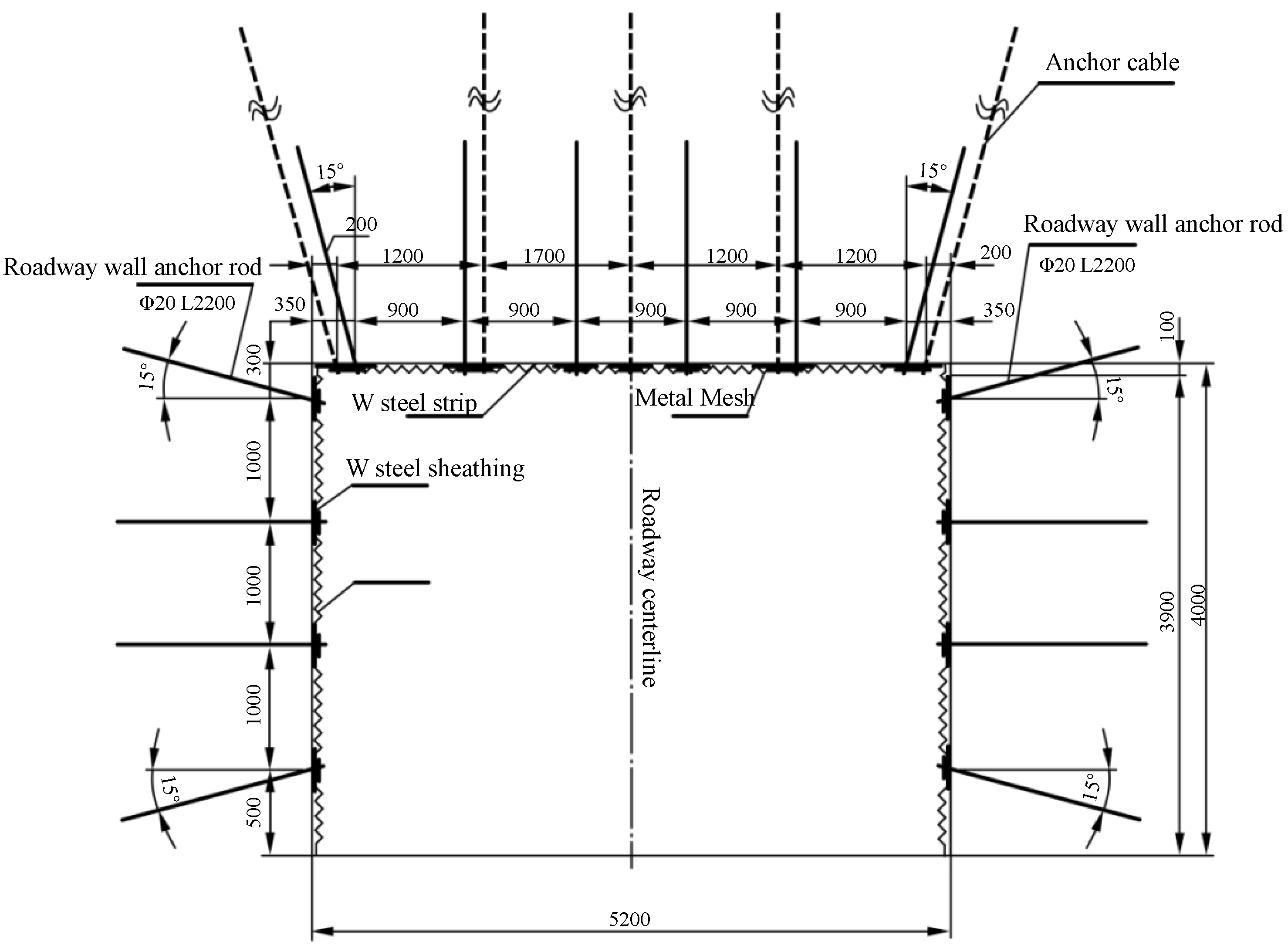
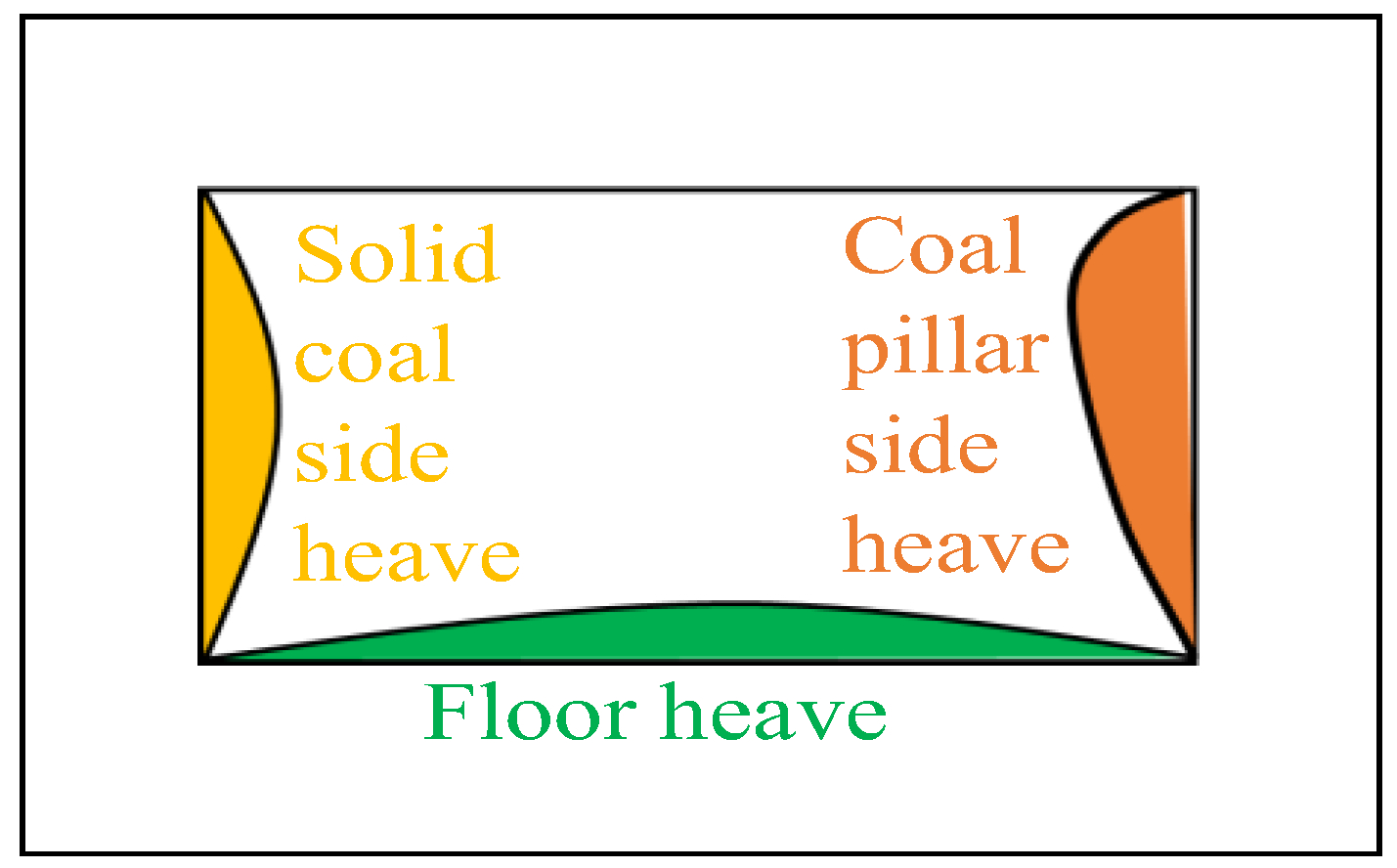

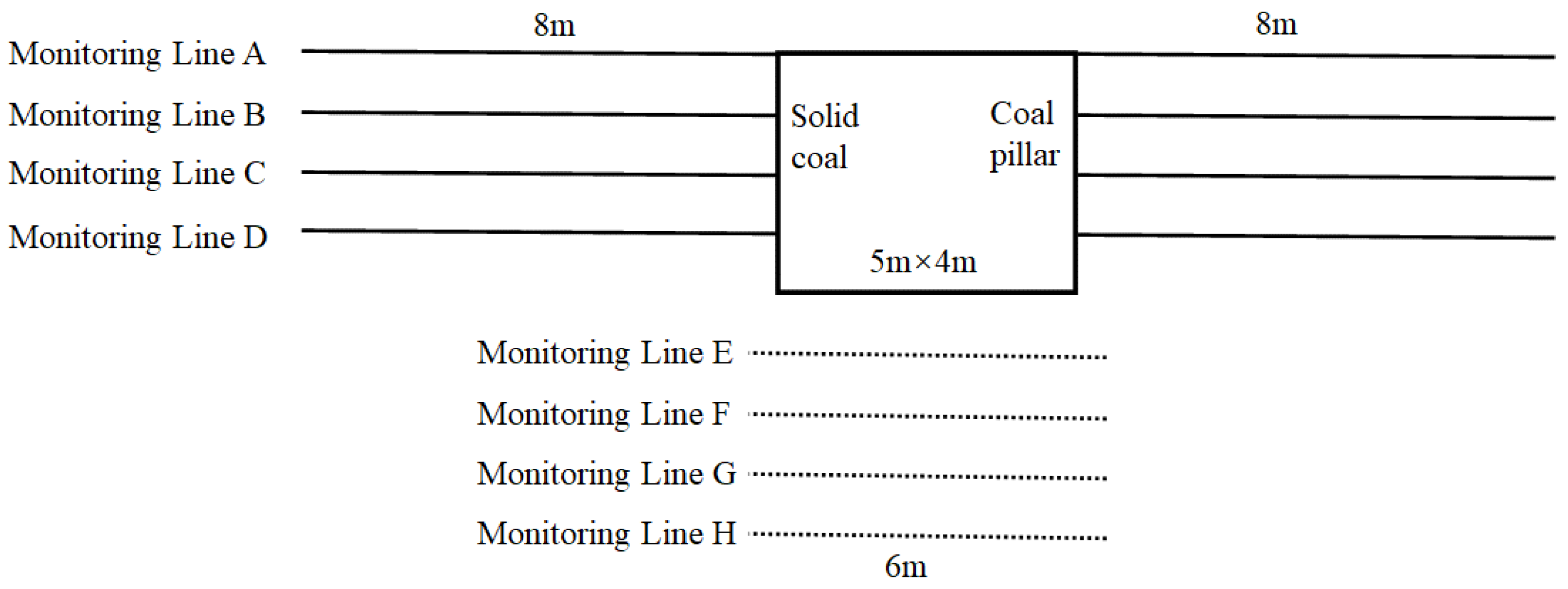
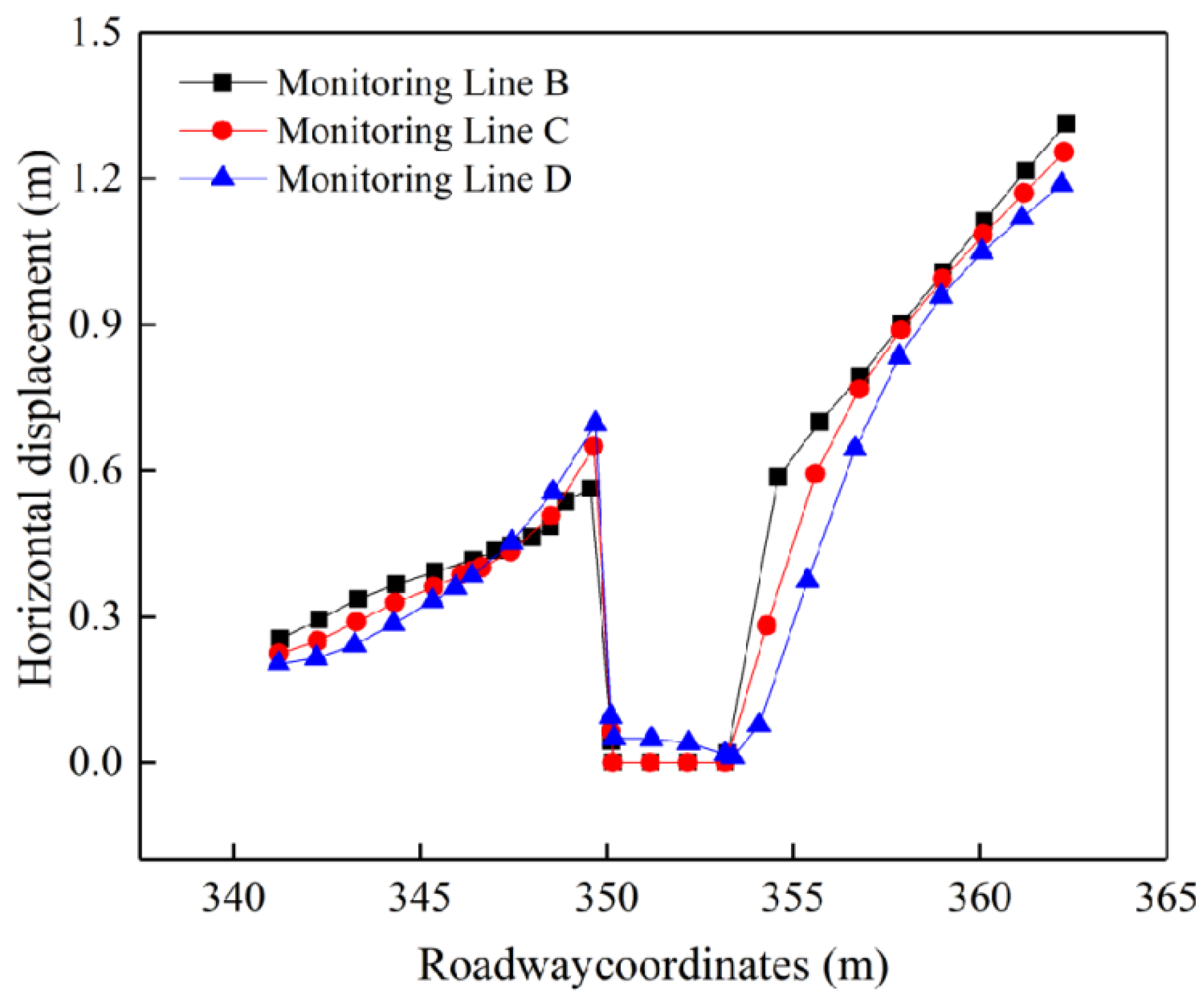
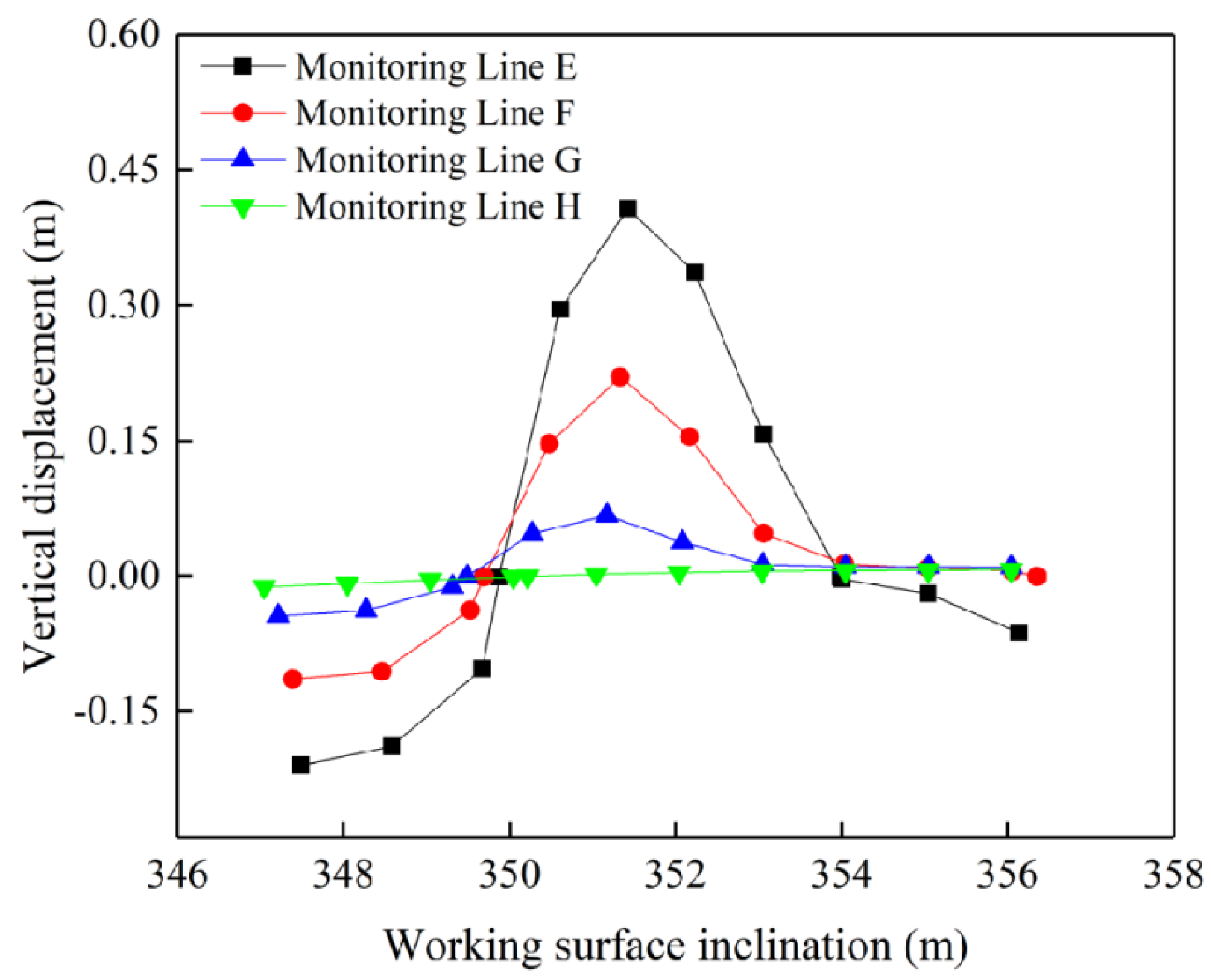
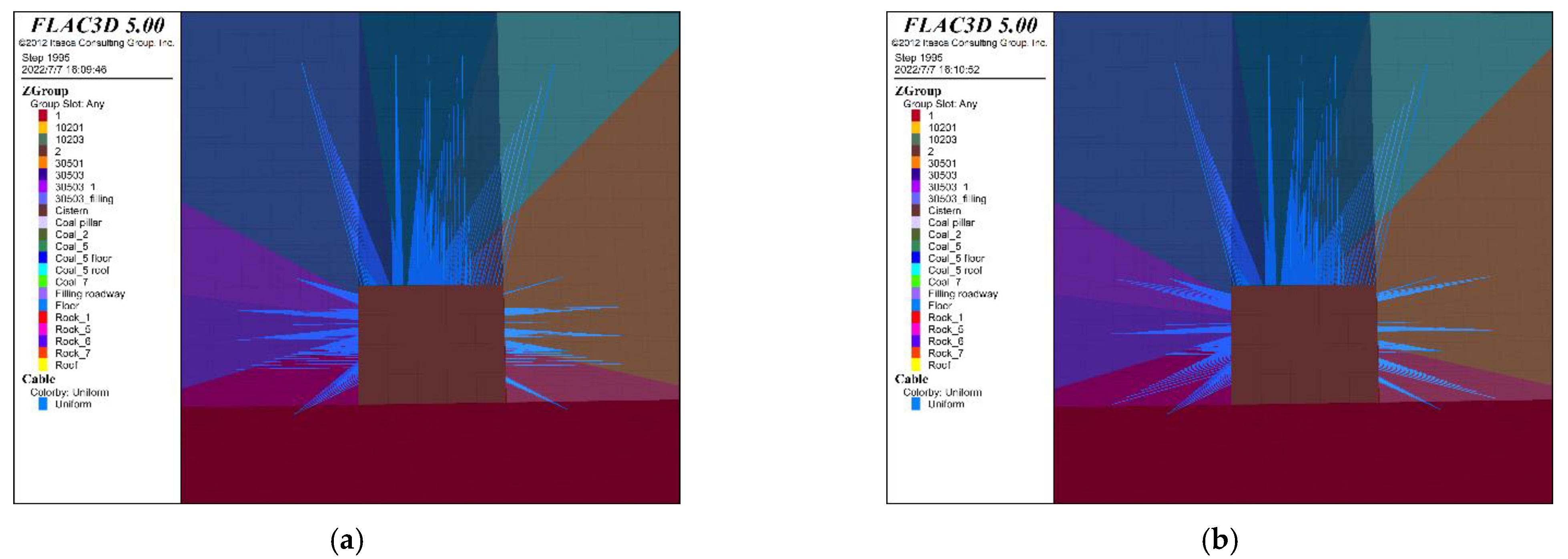


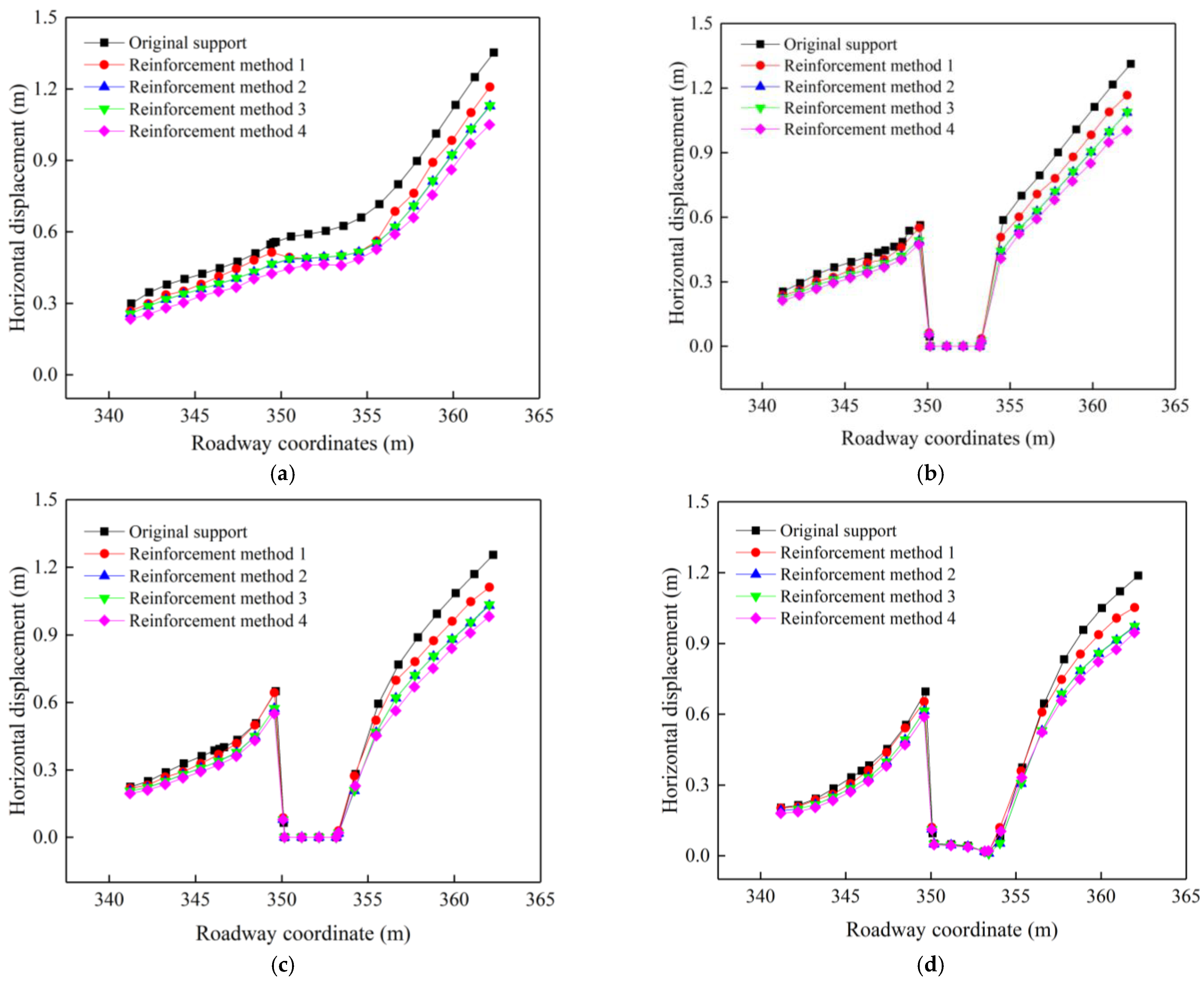
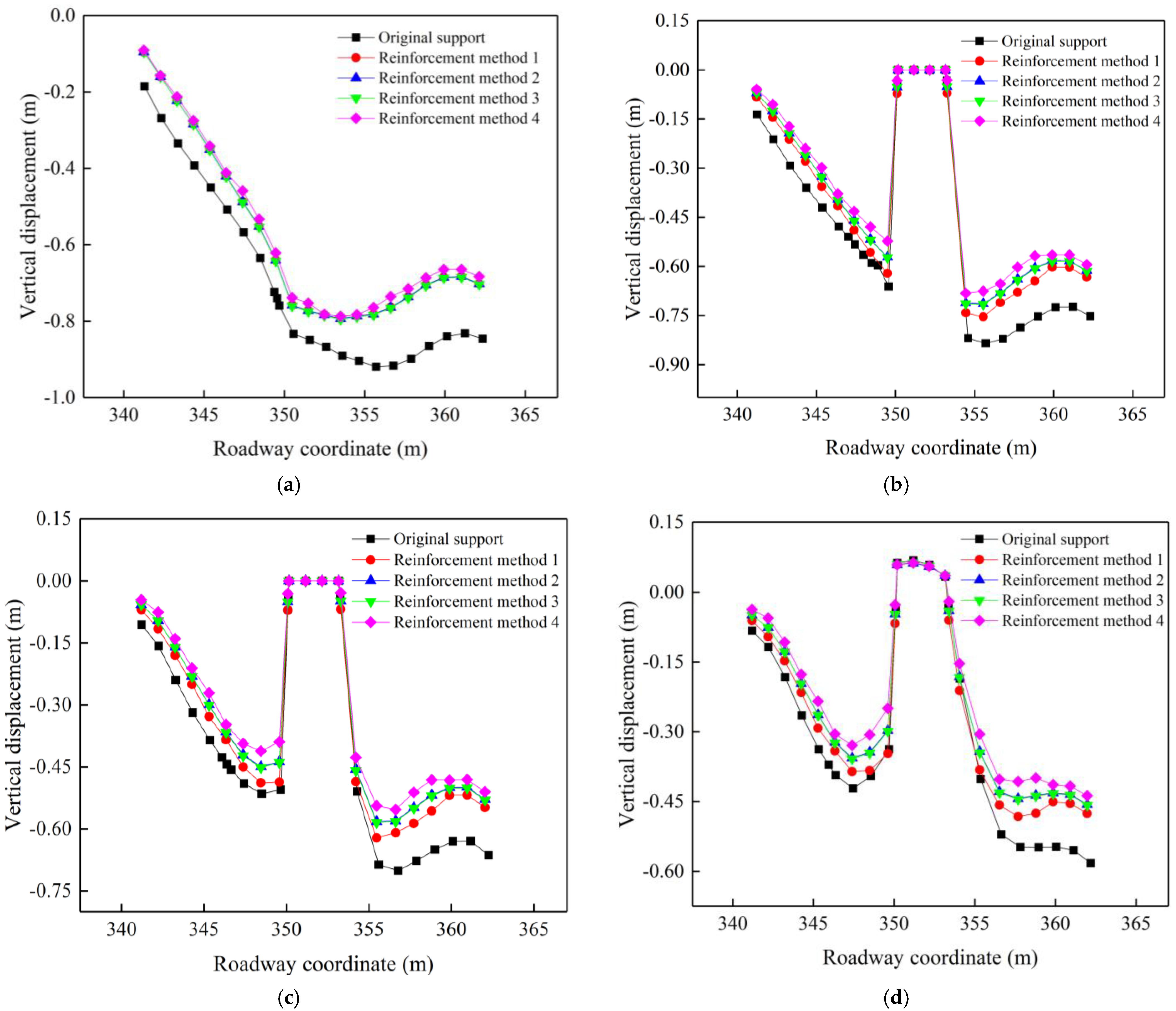

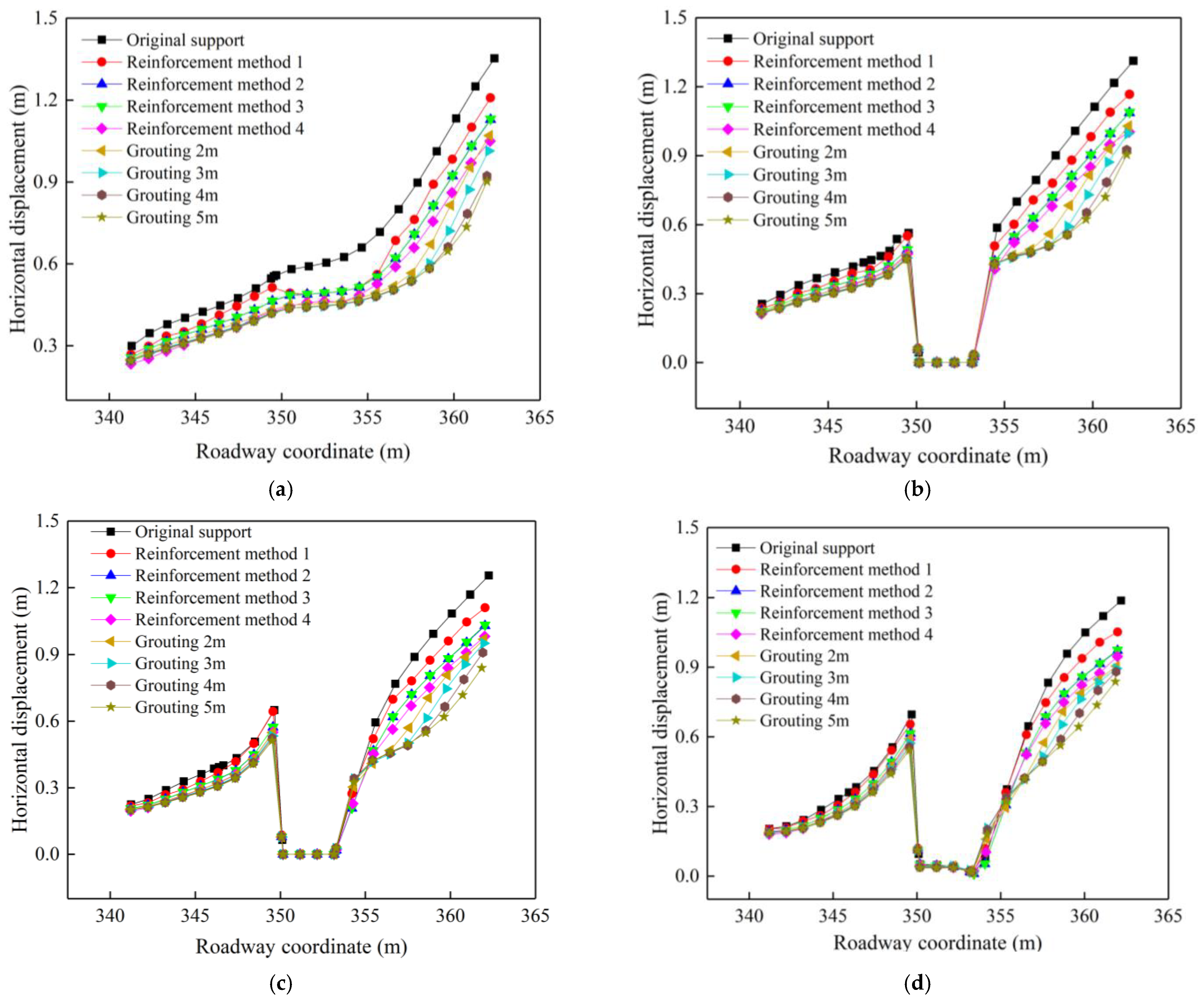
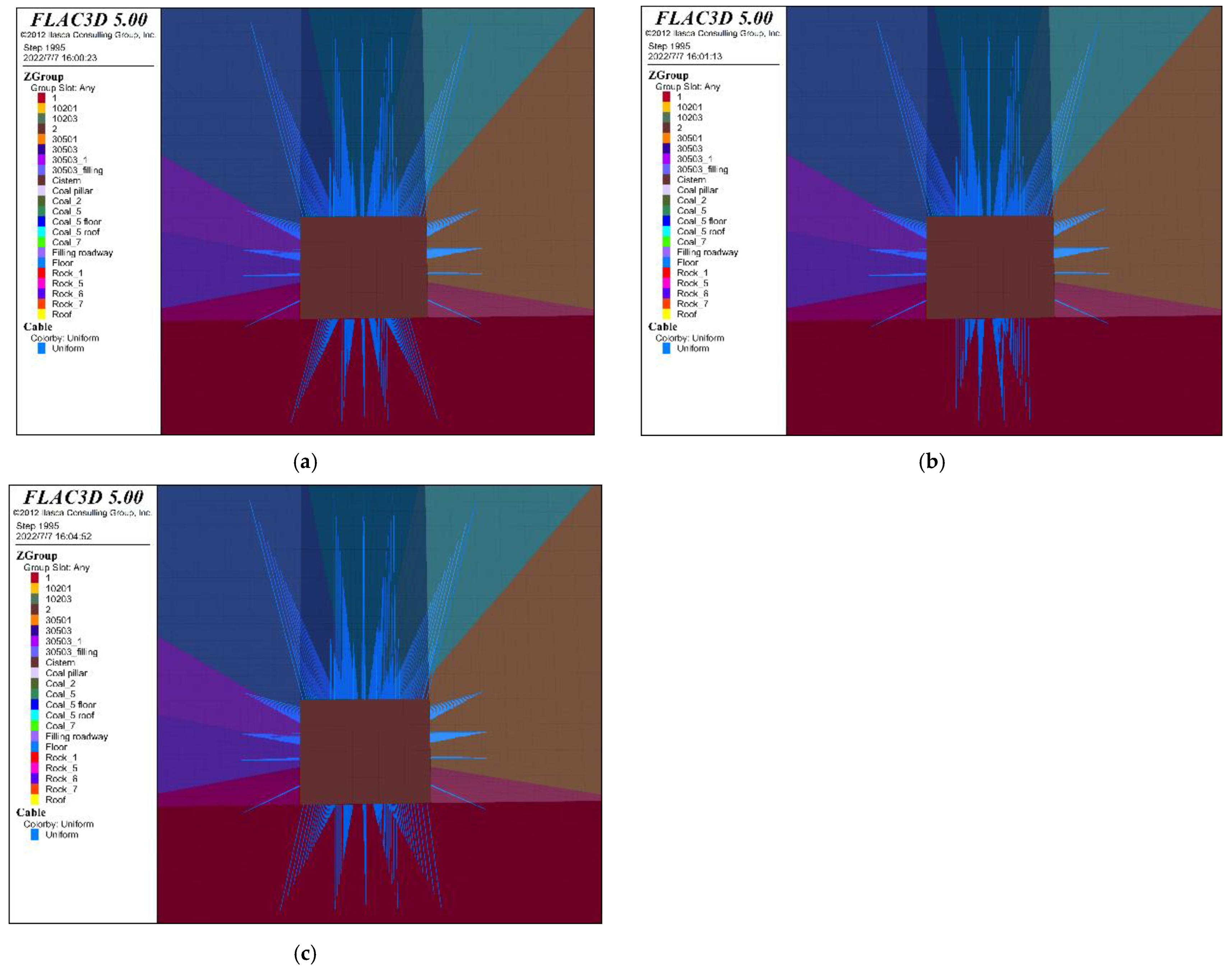

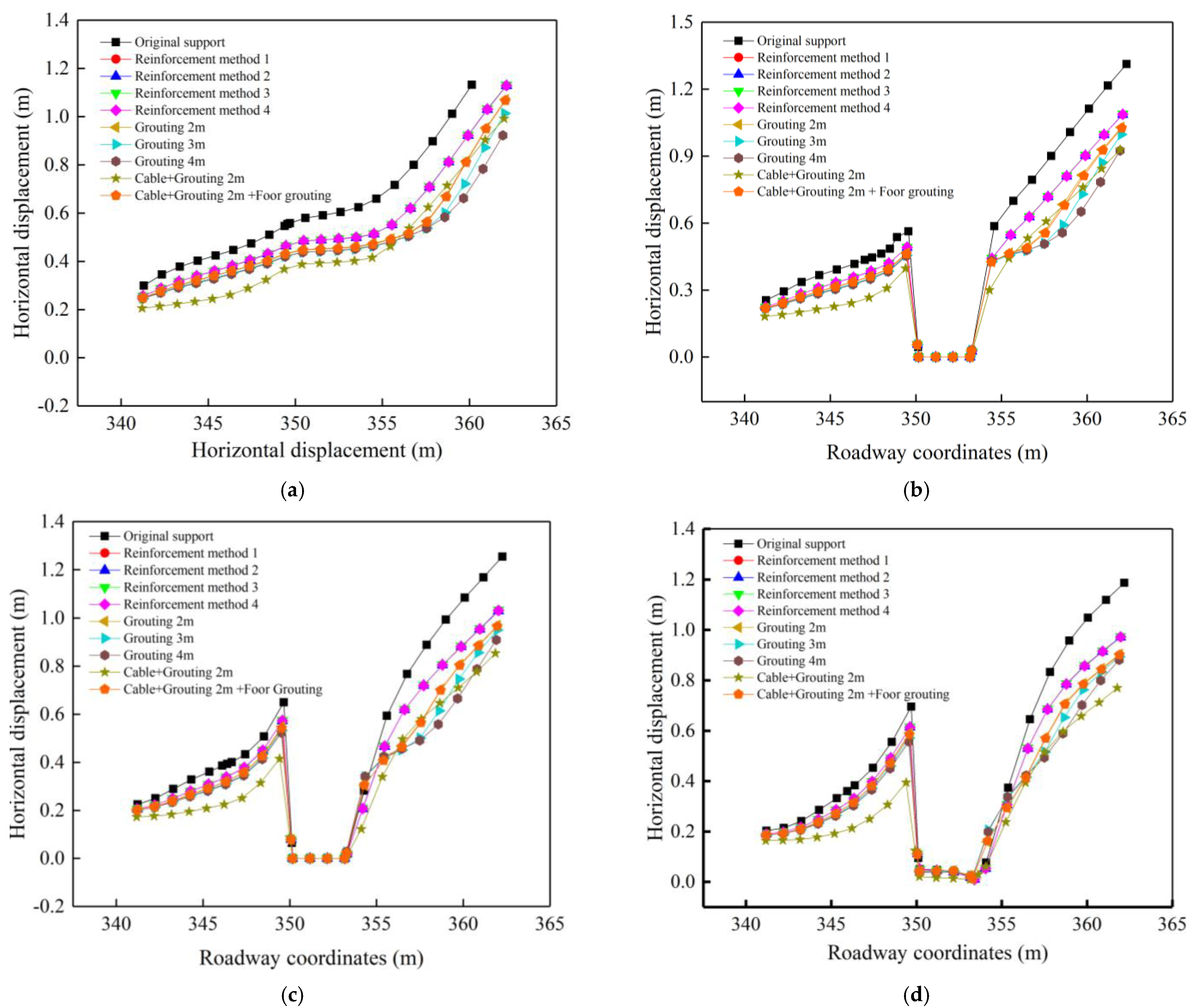
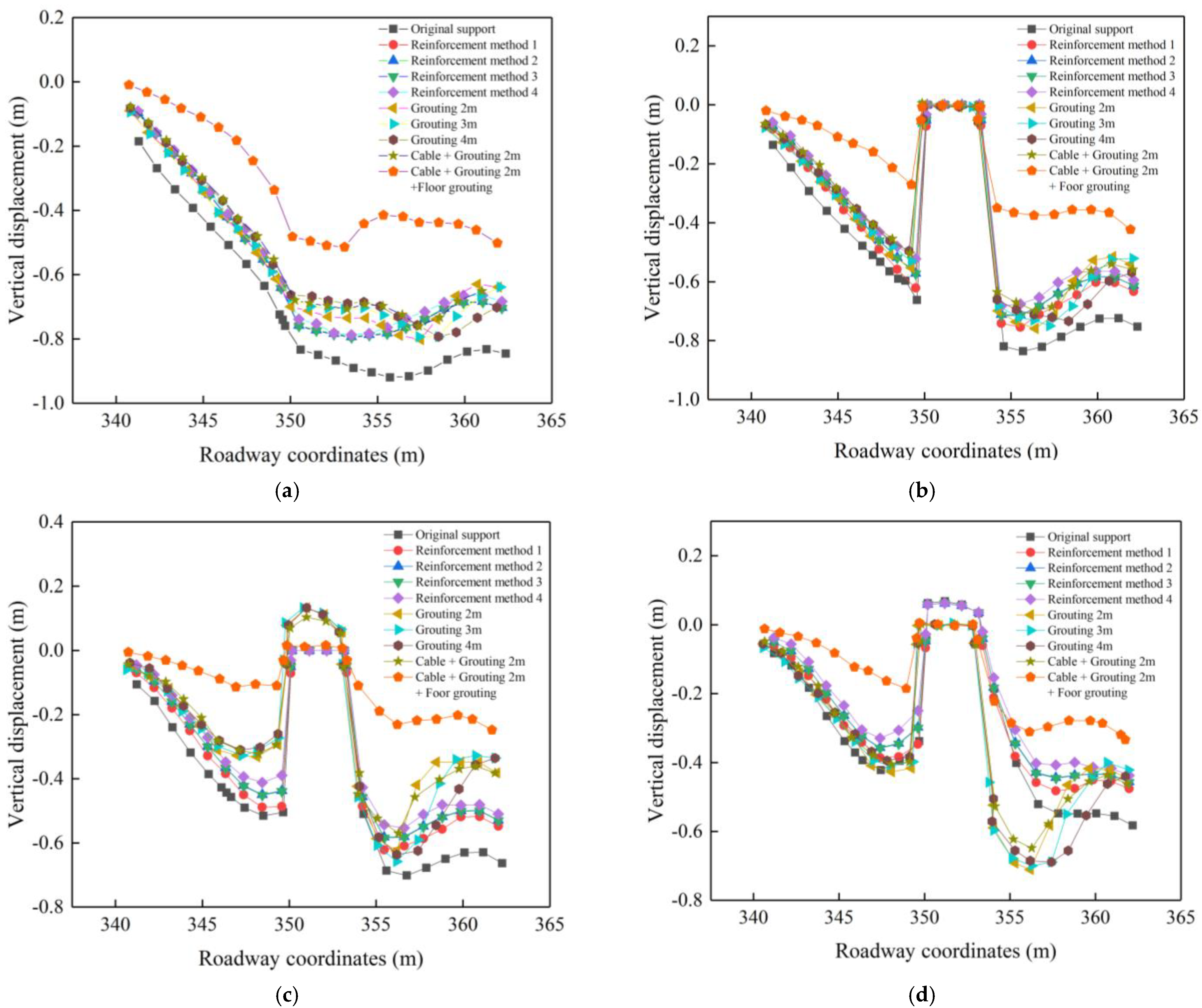
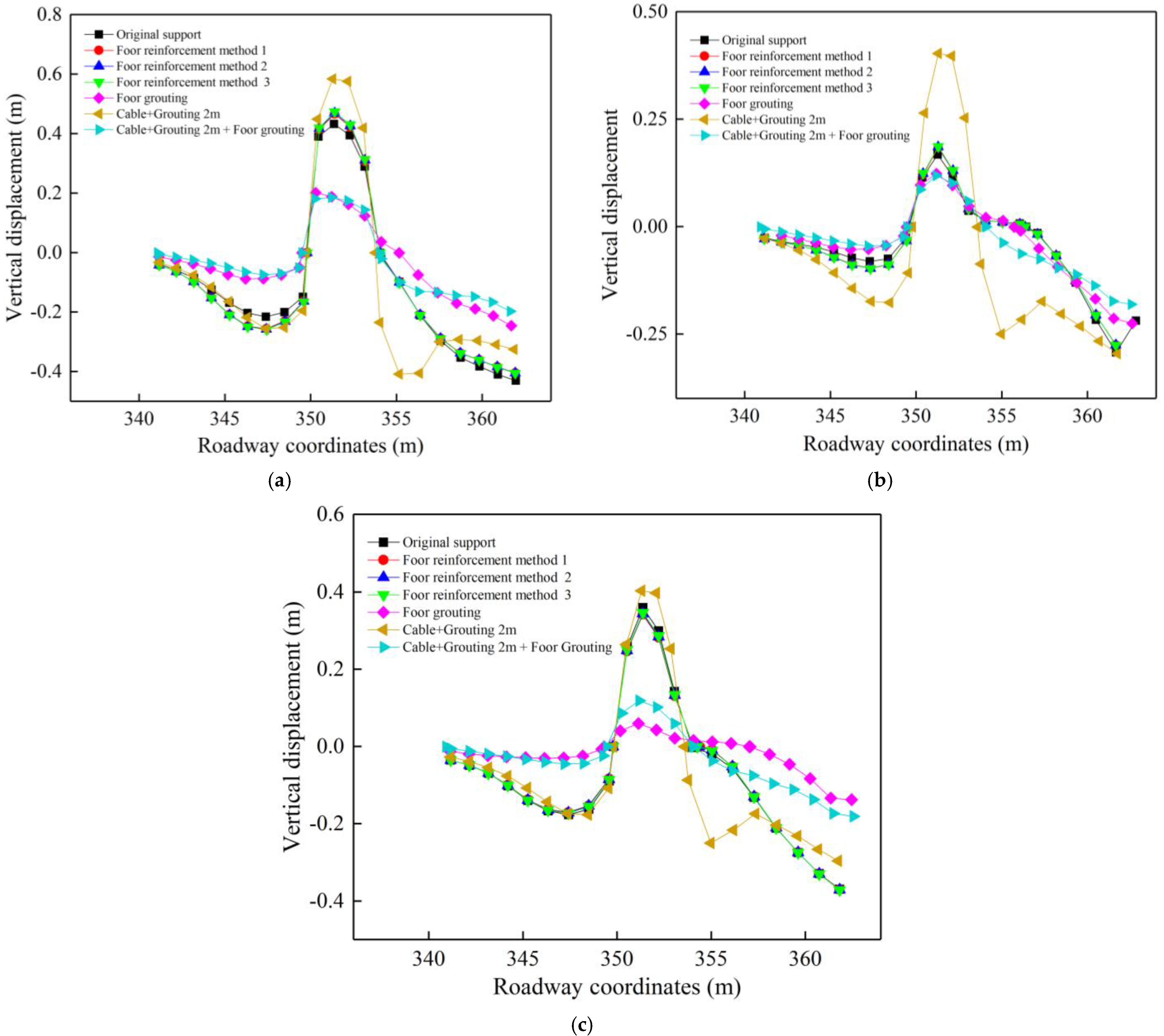
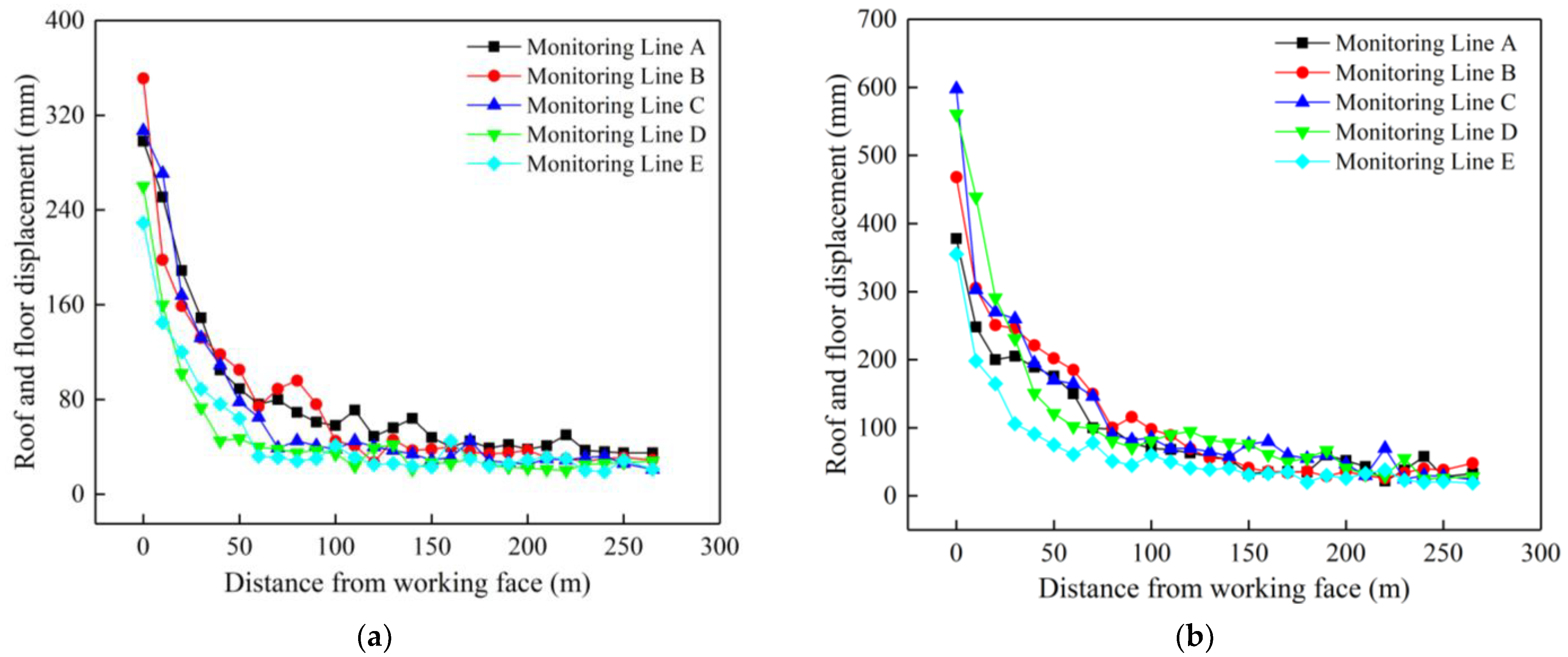
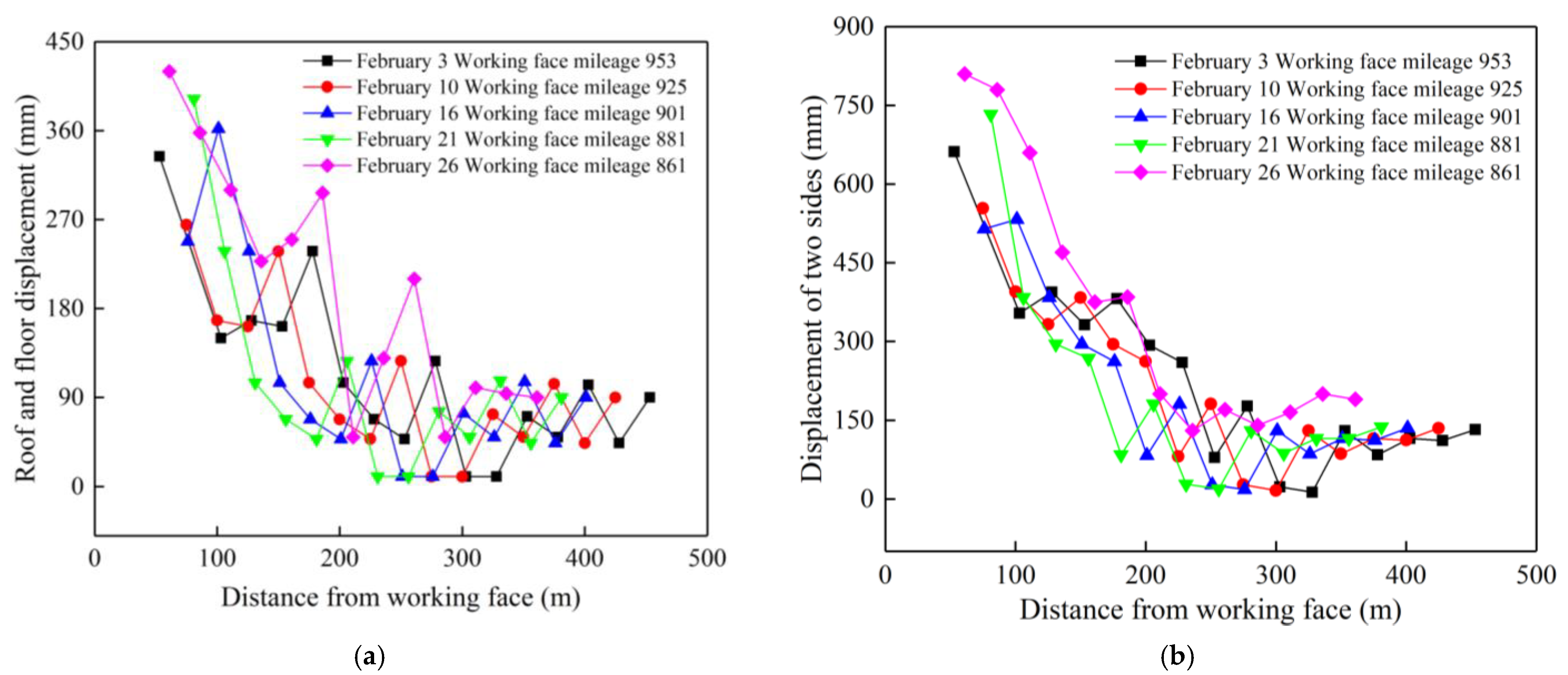
| Rockiness | Thickness (m) | Density (kg/m3) | Bulk Modulus (GPa) | Shear Modulus (GPa) | Cohesion (MPa) | Internal Friction Angle (°) | Tensile Strength (MPa) |
|---|---|---|---|---|---|---|---|
| Sandy mudstone | 51 | 2400 | 5.08 | 3.5 | 2.78 | 32.21 | 1.32 |
| Clasticite | 15 | 2450 | 5.49 | 3.78 | 2.94 | 33.15 | 1.52 |
| Fine Sandstone | 3 | 2470 | 8.77 | 6.58 | 4.77 | 36.79 | 2.98 |
| Sandy mudstone | 8 | 2400 | 5.08 | 3.5 | 2.78 | 32.21 | 1.32 |
| 2# Coal | 3 | 1340 | 4.93 | 3.25 | 2.67 | 31.22 | 1.04 |
| Kaolinite | 5 | 2500 | 7.8 | 7.63 | 5.86 | 32.17 | 1.57 |
| 3~5# coal | 14 | 1340 | 4.93 | 3.25 | 2.67 | 31.22 | 1.04 |
| Kaolinite mud | 4 | 2546 | 6.65 | 4.33 | 3.63 | 35.83 | 2.38 |
| Siltstone | 5 | 2470 | 7.81 | 5.62 | 4.24 | 35.93 | 2.71 |
| 7# Coal | 2 | 1340 | 4.93 | 3.25 | 2.67 | 31.22 | 1.04 |
| Sandy mudstone | 21 | 2400 | 5.08 | 3.5 | 2.78 | 32.21 | 1.32 |
| High water materials | 4 | 1310 | 1.1 | 0.7 | 0.25 | 31.22 | 0.5 |
| Type | Bolt Length/mm | Grout Length/mm | Diameter/mm | Tensile Strength/kN | Row Spacing/mm |
|---|---|---|---|---|---|
| Anchor rods | 8300 | 2700 | 20 | 200 | 1300 × 1000 |
| Anchor cables | 2400 | 800 | 22 | 120 | 1000 × 1000 |
| Reinforcement Method/ Location | Method 1 | Method 2 | Method 3 | Method 4 |
|---|---|---|---|---|
| Monitoring Line A | 5.00% | 14.80% | 14.80% | 22.00% |
| Monitoring Line B | 5.00% | 11.00% | 11.00% | 16.00% |
| Monitoring Line C | 11.00% | 14.00% | 14.00% | 18.70% |
| Monitoring Line D | 5.00% | 16.00% | 16.00% | 20.00% |
| Reinforcement Method/ Location | Method 1 | Method 2 | Method 3 | Method 4 |
|---|---|---|---|---|
| Monitoring Line A | 11.80% | 19.80% | 19.8% | 27.70% |
| Monitoring Line B | 15.50% | 22.20% | 22.2% | 27.00% |
| Monitoring Line C | 11.30% | 18.20% | 18.2% | 26.00% |
| Monitoring Line D | 10.80% | 18.00% | 18.0% | 22.00% |
| Reinforcement Method/ Location | Method 1 | Method 2 | Method 3 | Method 4 |
|---|---|---|---|---|
| Monitoring Line A | 14.00% | 15.60% | 15.60% | 17.00% |
| Monitoring Line B | 6.00% | 13.00% | 13.00% | 21.00% |
| Monitoring Line C | 4.00% | 11.70% | 11.70% | 27.50% |
| Monitoring Line D | 4.800% | 12.20% | 12.20% | 26.00% |
| Reinforcement Method/ Location | Method 1 | Method 2 | Method 3 | Method 4 |
|---|---|---|---|---|
| Monitoring Line A | 10.00% | 20.00% | 20.00 | 21.30% |
| Monitoring Line B | 13.00% | 17.90% | 17.90% | 23.00% |
| Monitoring Line C | 12.00% | 19.40% | 19.40% | 25.00% |
| Monitoring Line D | 14.20% | 21.40% | 21.40% | 28.00% |
Publisher’s Note: MDPI stays neutral with regard to jurisdictional claims in published maps and institutional affiliations. |
© 2022 by the authors. Licensee MDPI, Basel, Switzerland. This article is an open access article distributed under the terms and conditions of the Creative Commons Attribution (CC BY) license (https://creativecommons.org/licenses/by/4.0/).
Share and Cite
Zhao, B.; He, S.; He, X.; Gao, L.; Li, Z.; Song, D.; Shen, F. Research on Deformation and Failure Control Technology of a Gob-Side Roadway in Close Extra-Thick Coal Seams. Sustainability 2022, 14, 11246. https://doi.org/10.3390/su141811246
Zhao B, He S, He X, Gao L, Li Z, Song D, Shen F. Research on Deformation and Failure Control Technology of a Gob-Side Roadway in Close Extra-Thick Coal Seams. Sustainability. 2022; 14(18):11246. https://doi.org/10.3390/su141811246
Chicago/Turabian StyleZhao, Bin, Shengquan He, Xueqiu He, Le Gao, Zhenlei Li, Dazhao Song, and Feng Shen. 2022. "Research on Deformation and Failure Control Technology of a Gob-Side Roadway in Close Extra-Thick Coal Seams" Sustainability 14, no. 18: 11246. https://doi.org/10.3390/su141811246
APA StyleZhao, B., He, S., He, X., Gao, L., Li, Z., Song, D., & Shen, F. (2022). Research on Deformation and Failure Control Technology of a Gob-Side Roadway in Close Extra-Thick Coal Seams. Sustainability, 14(18), 11246. https://doi.org/10.3390/su141811246








